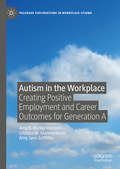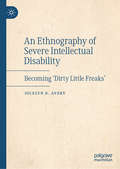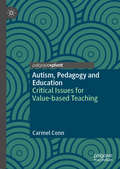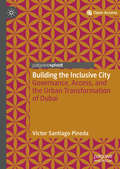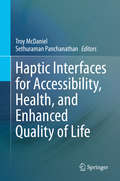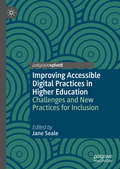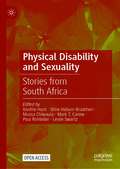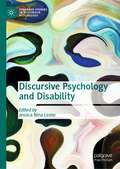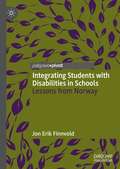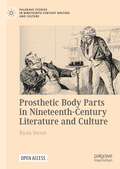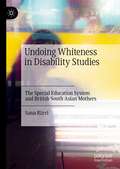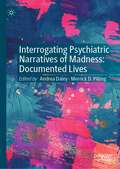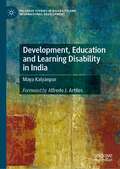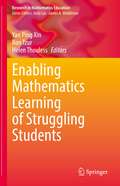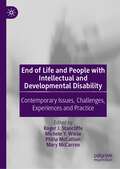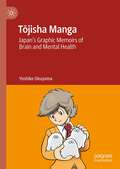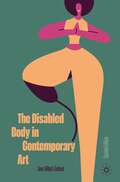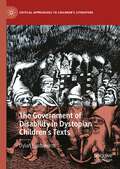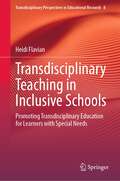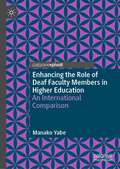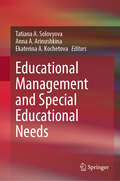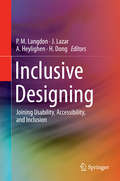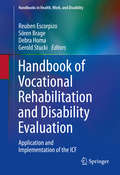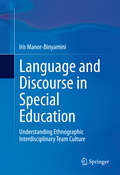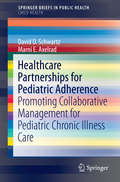- Table View
- List View
Autism in the Workplace: Creating Positive Employment and Career Outcomes for Generation A (Palgrave Explorations in Workplace Stigma)
by Amy E. Hurley-Hanson Cristina M. Giannantonio Amy Jane GriffithsThis book explores the career experiences of Generation A, the half-million individuals with autism spectrum disorder (ASD) who will reach adulthood in the next decade. With Generation A eligible to enter the workforce in unprecedented numbers, research is needed to help individuals, organizations, and educational institutions to work together to create successful work experiences and career outcomes for individuals with ASD. Issues surrounding ASD in the workplace are discussed from individual, organizational, and societal perspectives. This book also examines the stigma of autism and how it may affect the employment and career experiences of individuals with ASD. This timely book provides researchers, practitioners, and employers with empirical data that examines the work and career experiences of individuals with ASD. It offers a framework for organizations committed to hiring individuals with ASD and enhancing their work experiences and career outcomes now and in the future.
An Ethnography of Severe Intellectual Disability: Becoming 'Dirty Little Freaks'
by Jocelyn D. AveryIn this ethnographic investigation of a special education needs college in Australia, Jocelyn D. Avery explores how the self-identity of people with severe intellectual identities is influenced by carers and support people in their lives. Employing theoretical foundations of self-identity and embodiment and drawing largely on Mary Douglas’s (1996) notions of ritual and hygiene, purity and danger, Avery argues that students in this environment are treated as though they exist in a vacuum, rather than a highly complex social environment: strategies to ‘contain’ their difficult selves ultimately lead to continued confinement, as if the students themselves were ‘contaminated’. In the midst of this much-needed ethnography, Avery meditates on her own role: matters of consent, communication, and cooperation pose a challenge to anthropological engagement with severe intellectual disability, but researcher ethics and positionality have their own difficulties. The reflection provided here will provide a guide for future researchers to sensitively engage with people with disability.
Autism, Pedagogy and Education: Critical Issues for Value-based Teaching
by Carmel ConnThis book discusses critical issues concerning autism and education, and what constitutes effective pedagogy for this group of learners. Autism is a high-profile area within the discipline of special education, and the issue of how to teach autistic learners remains a contested one: recent theorising has questioned a techno-rationalist approach that places the burden of change on the autistic pupil. The author explores the values that underpin educational approaches within existing pedagogical practice: while these approaches have their individual merits and shortcomings, this book introduces and expands upon a strengths-based approach. This book will appeal to students and scholars of autism and education, with particular regard to teaching autistic learners.
Building the Inclusive City: Governance, Access, and the Urban Transformation of Dubai
by Victor Santiago PinedaThis Open Access book is an anthropological urban study of the Emirate of Dubai, its institutions, and their evolution. It provides a contemporary history of disability in city planning from a non-Western perspective and explores the cultural context for its positioning. Three insights inform the author’s approach. First, disability research, much like other urban or social issues, must be situated in a particular place. Second, access and inclusion forms a key part of both local and global planning issues. Third, a 21st century planning education should take access and inclusion into consideration by applying a disability lens to the empirical, methodological, and theoretical advances of the field. By bridging theory and practice, this book provides new insights on inclusive city planning and comparative urban theory. This book should be read as part of a larger struggle to define and assert access; it’s a story of how equity and justice are central themes in building the cities of the future and of today.
Haptic Interfaces for Accessibility, Health, and Enhanced Quality of Life
by Troy McDaniel Sethuraman PanchanathanThis book is the first resource to provide in-depth coverage on topical areas of assistive, rehabilitative, and health-related applications for haptic (touch-based) technologies. Application topics are grouped into thematic areas spanning haptic devices for sensory impairments, health and well-being, and physical impairments which are illustrated in this book. A diverse group of experts in the field were invited to contribute different chapters to provide complementary and multidisciplinary perspectives. Unlike other books on haptics, which focus on human haptic perception, specific modalities of haptics (e.g., realistic haptic rendering), or broadly cover the subfields of haptics, this book takes an application-oriented approach to present a tour of how the field of haptics has been advanced with respect to important, impactful thematic focuses.Under Theme 1 “Sensory Impairments”, haptics technologies to support individuals with sensory impairments is presented which includes: Spatial awareness in sensory impairments through touch; Haptically-assisted interfaces for persons with visual impairments; and Enabling learning experiences for visually impaired children by interaction design. Under Theme 2 “Haptics for Health and Well-Being”, haptics technologies aimed at supporting exercise and healthy aging will be covered including: Haptics in rehabilitation, exergames and health; Therapeutic haptics for mental health and well-being; and Applications of haptics in medicine. Under Theme 3 “Haptics for Physical Impairments”, haptics technologies for enhancing the quality of life for individuals with weakened/impaired limbs or neurological diseases impacting movement is targeted including: Assistive soft exoskeletons with pneumatic artificial muscles; Haptics for accessibility in rehabilitative hardware; and intelligent robotics and immersive displays for enhancing haptic interaction in physical rehabilitation environments.Engineers, scientists, and researchers working in the areas of haptics, multimedia, virtual/augmented/mixed-reality, human-computer interaction, assistive technologies, rehabilitative technologies, healthcare technologies, and/or actuator design will want to purchase this book. Advanced level students and hobbyists interested in haptics will also be interested in this book.
Improving Accessible Digital Practices in Higher Education: Challenges and New Practices for Inclusion
by Jane SealeThis book examines the role played by technologies in removing the disadvantage experienced by students with disabilities in higher education. Addressing five key themes, the editor and contributors explore the practices required of stakeholders within higher education institutions to mediate successful and supportive relationships between disabled learners and their technologies. Ultimately, the book argues that practice in the fields of disability, ICT and higher education is still not providing consistent and widespread positive learning experiences to students with disabilities. In order to address this situation, the field needs to creatively integrate knowledge gained through both research and practice, and to re-imagine what is needed for ICT to meaningfully contribute to a reduction in disadvantage for disabled students. This book will be of interest and value to scholars of disability studies, education and accessibility, and educational technologies.
Physical Disability and Sexuality: Stories from South Africa
by Leslie Swartz Poul Rohleder Xanthe Hunt Stine Hellum Braathen Mussa Chiwaula Mark T. CarewThis open access edited volume explores physical disability and sexuality in South Africa, drawing on past studies, new research conducted by the editors, and first-person narratives from people with physical disabilities in the country. Sexuality has long been a site of oppression and discrimination for people with disabilities based on myths and misconceptions, and this book explores how these play out for people with physical disabilities in the South African setting. One myth with which the book is centrally concerned, is that people with disabilities are unable to have sex, or are seen as lacking sexuality by society at large. Societal understandings of masculinity, femininity, bodies and attractiveness, often lead people with physical disabilities to be seen as being undesirable romantic or sexual partners. The contributions in this volume explore how these prevailing social conditions impact on the access to sexual and reproductive healthcare, involvement in romantic relationships, childbearing, and sexual citizenship as a whole, of people with physical disabilities in the Western Cape of the country. The authors' research, and first person contributions by people with physical disabilities themselves, suggest that education and public health policy must change, if the sexual and reproductive health rights and full inclusion of people with disabilities are to be achieved.
Discursive Psychology and Disability (Palgrave Studies in Discursive Psychology)
by Jessica Nina LesterThis book explores how discursive psychology (DP) research can be applied to disability and the everyday and institutional constructions of bodymind differences. Bringing together both theoretical and empirical work, it illustrates how DP might be leveraged to make visible nuanced understandings of disability and difference writ large. The authors argue that DP can attend to how such realities are made relevant, dealt with, and negotiated within social practices in the study of disability. They contend that DP can be used to unearth the nuanced and frequently taken for granted ways in which disability is made real in both everyday and institutional talk, and can highlight the very ways in which differences are embodied in social practices – specifically at the level of talk and text. This book demonstrates that rather than simply staying at the level of theory, DP scholars can make visible the actual means by which disabilities and differences more broadly are made real, resisted, contested, and negotiated in everyday social actions. This book aims to expand conceptions of disability and to deepen the – at present, primarily theoretical – critiques of medicalization.
Integrating Students with Disabilities in Schools: Lessons from Norway
by Jon Erik FinnvoldThis book explores the ability of the Norwegian school system to support the achievement of formal competencies among children with physical disabilities, as well as its role in the informal dimensions of social participation and networking. Schools contribute to social inclusion in several ways: they are arenas for building official competencies, ensuring future access and success in the labour market. They are also sites for meeting other children, and developing friendships – friendships are not only important for strengthening cognitive development, but are vital to both good mental health and the building of various forms of social capital. By examining schools and the ways in which inclusion is incorporated early, this book aims to bridge the opportunity and employment gap that people with physical disabilities are more likely to face later in life.
Prosthetic Body Parts in Nineteenth-Century Literature and Culture (Palgrave Studies in Nineteenth-Century Writing and Culture)
by Ryan SweetThis open access book investigates imaginaries of artificial limbs, eyes, hair, and teeth in British and American literary and cultural sources from the nineteenth and early twentieth century. Prosthetic Body Parts in Nineteenth-Century Literature and Culture shows how depictions of prostheses complicated the contemporary bodily status quo, which increasingly demanded an appearance of physical wholeness. Revealing how representations of the prostheticized body were inflected significantly by factors such as social class, gender, and age, Prosthetic Body Parts in Nineteenth-Century Literature and Culture argues that nineteenth-century prosthesis narratives, though presented in a predominantly ableist and sometimes disablist manner, challenged the dominance of physical completeness as they questioned the logic of prostheticization or presented non-normative subjects in threateningly powerful ways. Considering texts by authors including Charles Dickens, Edgar Allan Poe, and Arthur Conan Doyle alongside various cultural, medical, and commercial materials, this book provides an important reappraisal of historical attitudes to not only prostheses but also concepts of physical normalcy and difference.
Undoing Whiteness in Disability Studies: The Special Education System and British South Asian Mothers
by Sana RizviThis book offers a nuanced way to conceptualise South Asian Muslim families’ experiences of disability within the UK. The book adopts an intersectional lens to engage with personal narratives on mothering disabled children, negotiating home-school relationships, and developing familiarity with the complex special education system. The author calls for a re-envisioning of special education and disability studies literature from its currently overwhelmingly White middle-class discourse, to one that espouses multi-ethnic and multi-faith perspectives. The book positions minoritised mothers at the forefront of the home-school relationship, who navigate the UK special education system amidst intersecting social inequalities. The author proposes that schools and both formal and informal institutions reformulate their roles in facilitating true inclusion for minoritised disabled families at an epistemic and systemic level.
Interrogating Psychiatric Narratives of Madness: Documented Lives
by Andrea Daley Merrick D. PillingThis book challenges the perception of the psychiatric chart as a neutral and objective text. The chapters included in this book coalesce to reveal the psychiatric chart as a text that is, in fact, “storied” by institutional ideology that reflects, reinforces, reinterprets, and, at times, resists gendered, raced, sexualized, and classed norms, values, and presuppositions. Intersectional analysis highlights the nuanced ways in which dominant ideologies are activated in chart documentation to produce qualitatively specific psychiatric narratives of distress and related responses in the psychiatric institution. The book serves as a much-needed resource for mental health professionals, education and training programs, and researchers that meaningfully takes into account the social and structural materiality of people’s lives and its impact on experiences of distress. It will also appeal to scholars investigating equity in health care across the fields of Critical Psychology, Disability Studies, Social Work, Allied Health, Mad Studies and Social Justice.
Development, Education and Learning Disability in India (Palgrave Studies in Disability and International Development)
by Maya KalyanpurThis book uses qualitative research methods to examine why students in an Indian context are being identified as having learning disabilities on criteria that are largely drawn from the context of the Global North. It explores the push towards English language instruction as a possible factor that affects poor academic outcomes for students from low-income backgrounds who may be first-generation learners or English language learners. The book contrasts the different outcomes and supports for academically struggling students across low-income and middle-income backgrounds, with evidence to suggest that, despite the inclusionary principles of Education For All, this label is creating a marginalized group of students.
Enabling Mathematics Learning of Struggling Students (Research in Mathematics Education)
by Yan Ping Xin Ron Tzur Helen ThoulessThis book provides prospective and practicing teachers with research insights into the mathematical difficulties of students with learning disabilities and classroom practices that address these difficulties. This linkage between research and practice celebrates teachers as learners of their own students’ mathematical thinking, thus contributing an alternative view of mathematical progression in which students are taught conceptually. The research-based volume presents a unique collaboration among researchers in special education, psychology, and mathematics education from around the world. It reflects an ongoing work by members of the International Group for the Psychology of Mathematics Education (PME) and the North American Chapter of the PME Working Groups. The authors of chapters in this book, who have been collaborating extensively over the past 7 years, are from Australia, Canada, the United Kingdom, and the United States.
End of Life and People with Intellectual and Developmental Disability: Contemporary Issues, Challenges, Experiences and Practice
by Roger J. Stancliffe Michele Y. Wiese Philip McCallion Mary McCarronThis book on end of life examines how to include people with intellectual and developmental disability in the inevitability of dying and death. Comprising 17 chapters, it addresses challenging and under-researched topics including suicide, do-not-resuscitate, advance care planning, death doulas and accessible funerals. Topics reflect everyday community, palliative care, hospice and disability services.The book proposes that the rights of people with disabilities should be supported up to and after their death. Going beyond problem identification, the chapters offer positive, evidence-supported responses that translate research to practice, together with practice examples and resources grounded in lived experience. The book is applicable to readers from the disability field, and mainstream health professionals who assist people with disability in emergency care, palliative care or end-of-life planning
Tōjisha Manga: Japan’s Graphic Memoirs of Brain and Mental Health
by Yoshiko OkuyamaThis book defines tōjisha manga as Japan’s autobiographical comics in which the author recounts the experience of a mental or neurological condition in a unique medium of text and image. Yoshiko Okuyama argues that tōjisha manga illuminate otherwise “faceless” individuals and humanize their invisible tribulations because the first-person narrative makes their lived experience more authentic and relatable to the reader. Part I introduces the evolution of the term tōjisha, the tōjisha movements, and other relevant social phenomena and concepts. Part II analyzes five representative titles to demonstrate the humanizing power of tōjisha manga, drawing on interviews with the authors of these manga and examining how psychological or brain-related symptoms are artistically depicted in approximately 40 drawings. This book is highly recommended to not only scholars of disability studies and comic studies but also global fans of manga who are interested in the graphic memoirs of serious social issues.
The Disabled Body in Contemporary Art
by Ann Millett-GallantThe second edition offers an essential update to the foundational first edition, The Disabled Body in Contemporary Art. Featuring updated chapters and case studies, this second edition will not only expand on the first edition but will bring a new focus to contemporary disabled artists and their embodied, multimedia work.
The Government of Disability in Dystopian Children’s Texts (Critical Approaches to Children's Literature)
by Dylan HoldsworthThis book takes up the task of mapping discursive shifts in the representation of disability in dystopian youth texts across four historical periods where major social, cultural and political shifts were occurring in the lives of many disabled people. By focusing on dystopian texts, which the author argues act as sites for challenging or reinforcing dominant belief systems and ways of being, this study explores the potential of literature, film and television to act as a catalyst of change in the representation of disability. In addition, this work discusses the texts and technologies that continue to perpetuate questionable and often competing discourses on the subject.
Transdisciplinary Teaching in Inclusive Schools: Promoting Transdisciplinary Education for Learners with Special Needs (Transdisciplinary Perspectives in Educational Research #8)
by Heidi FlavianThis book offers opportunities for better understanding teachers’ unique challenges when planning teaching sessions for learners with special needs, based on the transdisciplinary approach. The work also presents some of the core learning strategies teachers may incorporate into their teaching processes in order to promote transdisciplinary learning among learners with special needs.From a theoretical perspective, this book discusses a variety of advantages and disadvantages transdisciplinary educators may encounter, and promotes educators' development of their own vision of this area. Although the concept of special needs is often over-generalized, this book relates to the most common types of special needs among learners who study in inclusive schools: learners from different cultural background, learners with Attention Deficit Hyperactive Disability (ADHD), learners with Autism Spectrum Disorder (ASD), and learners with sensory or motor challenges. A special chapter is dedicatedto each of those groups in order to closely examine how teachers can teach those learners according to the transdisciplinary approach in practice, in inclusive classrooms. While each chapter presents different perspectives of learners with special needs, the book’s summary integrates them all and highlights the commonalities between the various needs.
Enhancing the Role of Deaf Faculty Members in Higher Education: An International Comparison
by Manako YabeThis book is based on an international, mixed methods research project that conducted interviews with 25 deaf or hard-of-hearing (DHH) faculty members from mainstream universities and 19 university students who took classes taught by DHH faculty members and collected surveys from 57 DHH faculty members and 104 university students worldwide. The author reports on their experiences of accessibility at their institutions and makes recommendations based on the findings. The book will serve as a user guide or supplemental text for DHH faculty members, researchers, students, and academic interpreters, as well as university administrators and disability service directors who are looking to improve disability provision at their institutions.
Educational Management and Special Educational Needs
by Tatiana A. Solovyova Anna A. Arinushkina Ekaterina A. KochetovaThis book systematizes the latest findings on the clinical, psychological, and pedagogical features of today’s children with special educational needs (SEN) and expands the scientific understanding that characterizes such children. The book develops a system of education and assistance for children with SEN, including children with locomotor disabilities, intellectual disabilities, autism spectrum disorders, and hearing and visual impairments. The book is intended for heads of educational authorities, parents, specialists working with children with special educational needs, psychologists, teachers, methodologists, specialists in the field of inclusive education, and students and teachers in special education of pedagogical and psychological departments of higher education institutions.
Inclusive Designing
by P. M. Langdon J. Lazar A. Heylighen H. Dong'Inclusive Designing' presents the proceedings of the seventh Cambridge Workshop on Universal Access and Assistive Technology (CWUAAT '14). It represents a unique multi-disciplinary workshop for the Inclusive Design Research community where designers, computer scientists, engineers, architects, ergonomists, policymakers and user communities can exchange ideas. The research presented at CWUAAT '14 develops methods, technologies, tools and guidance that support product designers and architects to design for the widest possible population for a given range of capabilities, within a contemporary social and economic context. In the context of developing demographic changes leading to greater numbers of older people and people with disabilities, the general field of Inclusive Design Research strives to relate the capabilities of the population to the design of products. Inclusive populations of older people contain a greater variation in sensory, cognitive and physical user capabilities. These variations may be co-occurring and rapidly changing leading to a demanding design environment. Recent research developments have addressed these issues in the context of: governance and policy; daily living activities; the workplace; the built environment, Interactive Digital TV and Mobile communications. Increasingly, a need has been identified for a multidisciplinary approach that reconciles the diverse and sometimes conflicting demands of Design for Ageing and Impairment, Usability and Accessibility and Universal Access. CWUAAT provides a platform for such a need. This book is intended for researchers, postgraduates, design practitioners, clinical practitioners, and design teachers.
Handbook of Vocational Rehabilitation and Disability Evaluation
by Reuben Escorpizo Sören Brage Debra Homa Gerold StuckiThis book presents the state of the art in the application and implementation of the WHO's International Classification of Functioning, Disability and Health (ICF) in the areas of vocational rehabilitation as a primary topic and disability evaluation as a secondary topic. Application of the ICF and implementation strategies toward a holistic and comprehensive approach to work disability and vocational rehabilitation programs are presented along with clinical cases and exercises. The ICF as a topic in health and disability has been gaining momentum since its approval by the World Health Assembly in 2001, and great progress has been made since then. However, the integration if the ICF in the realm of vocational rehabilitation has been lacking despite the fact that work and employment are a major area in people's lives, particularly those who have work disability. This book will advance the professional practice of vocational rehabilitation, rehabilitation counseling, occupational medicine, and allied health science.
Language and Discourse in Special Education
by Iris Manor-BinyaminiThis book examines the words and discourse as well as their meaning and impact on the everyday culture of a multidisciplinary team at a school for students with mental disabilities. The book examines the organizational, social, professional, and emotional experiences of team members from such disciplines as child and school psychology, special education, therapy (e. g. , occupational, speech), social work, and pediatric medicine within a special education school. It explores the ways in which team members describe and interpret the day-to-day requirements of working effectively in a special education school, using their own language and discourse from a subjective point of view. In addition, the book analyzes and interprets the influence of language and discourse on the outlook, behavior patterns, and the coping of team members working in the school with the students, among themselves as a team, and with the difficulties and dilemmas that concern them as well the solutions that they themselves introduce for all these issues. This book, with its focus on the unique and complex work environment of the multidisciplinary special education team, is essential reading for researchers, professionals, and graduate students in child and school psychology, therapeutic disciplines (e. g. , occupational, speech), social work, pediatric medicine, and allied mental health and medical fields.
Healthcare Partnerships for Pediatric Adherence
by David D. Schwartz Marni E. AxelradThis timely professional reference and educational resource applies current concepts of pediatric adherence to medical treatment to create a model for a family-centered, collaborative approach to managing chronic illness. At its core are the latest findings on adherence: the factors that encourage it, the barriers that derail it, and the most effective interventions for its improvement. The book's developmental lens highlights how adherence waxes and wanes across different stages of childhood and adolescence, and specialized chapters analyze social realities exacerbating adherence problems. And its end product is a framework for how patients, parents/caregivers, and providers can work together effectively for improved adherence and optimum outcomes. Included in the coverage: The scope and impact of nonadherence. Poverty, stress, and chronic illness management. Racial/ethnic health disparities and adherence. Reconsidering the idea of self-management. · Screening for nonadherence in pediatric patients. · A comprehensive behavioral health system for identifying and treating nonadherence. Healthcare Partnerships for Pediatric Adherence offers relevant contemporary perspective for pediatricians looking for new ways to reduce treatment failure, improve support to patients and their families, and promote patient involvement in their own care.
